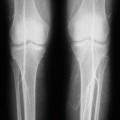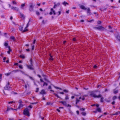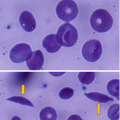(1)
Department of Surgery, Dar A lAlafia Medical Company, Qatif, Saudi Arabia
15.1 Introduction
A variety of neurological complications occur in patients with sickle cell anemia.
Approximately 25 % of patients with sickle cell anemia have a neurological event in their lifetime, many of these occur in childhood.
Cerebral infarction, either overt or clinically silent, is one of the major complications of the sickle cell anemia.
These neurological complications occur most commonly in patients with sickle cell anemia but have been seen in the other hemoglobinopathies, namely:
Sickle cell/hemoglobin C disease
Sickle cell/beta-thalassemia
Stroke (infarction or hemorrhagic) is caused by damage to either large or small cerebral vessels.
Overt stroke is associated with stenosis and occlusion of large cerebral arteries, especially those of the circle of Willis. These vessels may show increased aneurysm formation as an additional manifestation of the sickling-induced cerebral vasculopathy.
A mass of small friable vessels, similar to moyamoya disease, has been reported to occur as a consequent to the stenosis/occlusion of the cerebral arteries in patients with sickle cell anemia.
Rupture of aneurysms or of the moyamoya-like vessels results in hemorrhagic stroke, which is commonly subarachnoid but may be intraventricular or intraparenchymal.
The neurological complications of sickle cell anemia include:
Cerebral infarction
Intracranial hemorrhage
Spinal cord infarction
Isolated neuropathies due to anatomical proximity to infarcted bones
Lead neuropathy
Auditory complications
Ocular manifestations
The most devastating and most common complication is cerebral infarction.
There are a number of risk factors for stroke in patients with sickle cell anemia.
These include:
History of transient ischemic attacks
High systolic blood pressure
Increased steady-state leukocyte count
Severe anemia
Acute chest syndrome
Elevated cerebral blood flow velocity
Nocturnal hypoxemia
The majority of silent cerebral infarcts affect frontal lobe regions.
It was shown that children with SCA and silent cerebral infarction on neuroimaging commonly have neurocognitive dysfunction.
These patients suffer from a frontal lobe dysfunction syndrome, which can globally affect executive functioning in areas such as attention, concentration, information processing, and decision-making.
Those with silent cerebral infarcts have IQs in the low 80s, while those with overt stroke have IQs in the 70s.
Stroke is a devastating and potentially fatal complication of sickle cell anemia.
Stroke in patients with sickle cell anemia is usually associated with narrowing or occlusion of the large cerebral arteries including:
The internal carotid artery
The middle cerebral artery
The anterior cerebral artery
The basilar artery
Transcranial Doppler studies of children show that high blood flow velocity through these vessels is associated with higher probabilities of arterial occlusive stroke.
Children with flow rates of >190 cm/min through the internal carotid artery are at great risk of stroke.
Chronic blood transfusion therapy in patients identified by transcranial Doppler with increased cerebral blood flow velocity (>200 cm/s) prevented overt stroke.
The aim of the transfusion regimen is to maintain the hemoglobin S below 30 %.
This showed a relative stroke risk reduction of approximately 85 %.
Transfusion therapy remains the mainstay of management in the acute phase of cerebral infarction.
There is considerable evidence to indicate that long-term transfusion programs are effective in the prevention of recurrences.
This benefit clearly justifies the burden of monthly transfusion, its associated need for deferoxamine chelation therapy to prevent iron overload, and the continuing risk of alloimmunization.
There is a high recurrence rate of stroke in untreated patients.
In addition to the potentially devastating effect of stroke with its neurologic sequelae, “silent” infarcts appear to play an important role in the development of cognitive deficits.
15.2 Incidence
Cerebrovascular accident is defined as any acute neurologic event secondary to arterial occlusion or hemorrhage that results in an ischemic event associated with neurologic signs and/or symptoms.
Silent cerebral infarcts are defined as abnormal lesion seen on MRI of the brain with increased signal intensity on multiple T2-weighted images but no history or physical finding of a focal neurologic defect lasting more than 24 h.
A cerebrovascular accident is one of the leading causes of death in both children and adults with sickle cell anemia.
The reported age-adjusted incidence is 0.61–0.76 per 100 patient-years (i.e., 0.61–0.76 % per year) during the first 20 years of life.
This rate is approximately 300 times higher than that seen in children without SCA (0.0023 per 100 patient-years).
Silent cerebral infarcts have been reported to occur in as many as 22 % of patients by 14 years of age.
Patients with an existing silent cerebral infarct have an increased incidence of a new stroke (1.03 per 100 patient-years) and a marked incidence of new or more extensive silent cerebral infarcts (7.07 per 100 patient-years).
The frequency of cerebral infarction in patients with sickle cell anemia varies from 6 % to as high as 34 % in different reports.
The annual incidence of first stroke for those with sickle cell anemia was estimated as 0.6 per 100 patient-years, with the highest rate of 1.02 per 100 patient-years seen in the group aged 2–5 years.
The cumulative risk of stroke was 11 % by the age 20 years, increasing with age to 24 % by the age 45 years.
It was also found in the United States that the incidence per 100 patient-years of a first cerebral infarct was 0.70 between ages 2 and 5 years, 0.51 between ages 6 and 9 years, and 0.24 between ages 10 and 19 years and then fall to 0.04 between the ages of 20 and 29.
15.3 Mechanism of Stroke in Sickle Cell Anemia
The exact etiology of arterial occlusive stroke in patients with sickle cell disease is unknown.
The arterial lumen is usually occluded by a thrombus that includes red cells, platelets, and fibrin.
The red cell adherence to the endothelium which is mediated by von Willebrand’s protein may be an important factor in arterial occlusive stroke in patients with sickle cell anemia.
Von Willebrand’s protein enhances adherence of sickle red cells to endothelial cells.
The membranes of sickle red cells are strikingly abnormal. As a result, sickle red cell membranes have procoagulant activity.
Therefore, a cascade could occur in which von Willebrand’s protein promotes sickle red cell/endothelial cell adhesion, which then is a nidus for thrombus formation.
High rates of blood flow in these patients produce high linear sheer stress through the major cerebral arteries.
This leads to adherence of these sickled RBCs as well as platelets and fibrin leading to narrowing or occlusion of cerebral blood vessels.
The involvement of large arteries commonly produces severe neurological deficits.
Occlusion of the middle cerebral artery causes dense hemiparesis and aphasia if the stroke affects the dominant hemisphere of the brain. Cerebral edema with secondary brain stem compression is often fatal.
15.4 Treatment of Stroke
Stroke is a life-threatening event for patients with sickle cell anemia.
Exchange blood transfusion followed by chronic blood transfusion to maintain the level of HbS at <30 % is the treatment of choice.
Patients with stroke run a risk of recurrence of about 50 % in the absence of chronic transfusion.
The duration of chronic transfusion needed to prevent recurrent stroke is undefined.
Clearly, most children do not continue indefinitely with chronic transfusion after a stroke.
Cessation of chronic transfusion after as long as 5 years was associated with a high incidence of recurrent stroke in some studies.
15.5 Preventive Measures
Physicians caring for children with sickle cell anemia should consider instituting yearly examinations by transcranial Doppler.
A chronic transfusion regimen would be considered for children in which the blood flow rate in the assessed artery is >190 cm/min.
Chronic blood transfusion therapy in patients with sickle cell anemia is beneficial and not only prevents strokes but also has several other clinical advantages including decreased incidence of:
Recurrent vaso-occlusive pain necessitating hospitalization
Priapism
Avascular necrosis
Acute chest syndrome
Chronic blood transfusion therapy is known to be associated with adverse effects including:
Transfusion reactions
Central venous catheter placement
Red cell alloimmunization
Burdens regarding monthly clinic visits with associated missed school and work time
Transmission of infections including hepatitis B, hepatitis C, and HIV
Iron overload
The duration of blood transfusion therapy for the secondary prevention of silent cerebral infarcts is unknown, but it has been suggested that a minimum of 3 years of therapy should be considered.
The type of stroke varies with age.
An ischemic infarct is most common in children between the ages of 2 and 9, uncommon between the ages of 20 and 29, and has a second peak in adults over age 29.
Hemorrhagic stroke can occur in children but is most frequent in individuals between the ages of 20 and 29.
It was found that among first cerebrovascular accidents in patients with SCA:
54 % were caused by cerebral infarction
11 % were caused by TIA
34 % were caused by intracranial hemorrhage
1 % had features of both infarction and hemorrhage
15.6 Investigations
Computed tomographic (CT) scanning and magnetic resonance imaging (MRI) have become the accepted methods for confirming a clinical diagnosis of cerebral infarction or intracranial hemorrhage in patients with sickle cell anemia.
MRI offers improved resolution and the ability to demonstrate areas of abnormality within 2–4 h following an infarct.
Transcranial Doppler can be used to identify patients at risk for stroke.
Magnetic resonance angiography (MRA) can identify vascular disease.
Positron emission tomography (PET) scan can be used to assess the functional activity of the cerebral tissues and, therefore, microvascular blood flow.
PET scanning in conjunction with MRI may identify a greater number of patients with silent infarcts than does MRI alone.
15.7 Cerebral Infarction
Cerebral infarction is defined clinically by the presence of typical symptoms that last for at least 24 h.
Symptoms of infarctive stroke may include:
Hemiparesis
Dysphasia
Gait disturbance
A change in the level of consciousness
Cerebral infarction is associated largely with occlusion or stenosis of the large intracranial arteries.
Stay updated, free articles. Join our Telegram channel

Full access? Get Clinical Tree







